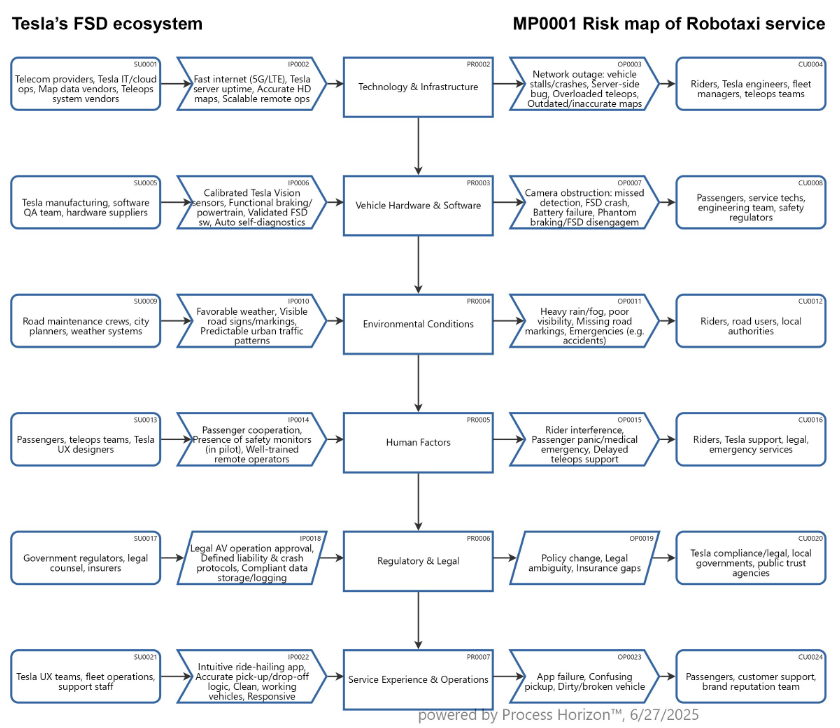Risk map for Tesla’s Full Self-Driving (FSD) ecosystem

The risk mapping goal for Tesla’s Full Self-Driving (FSD) ride-hailing ecosystem is to enable the Robotaxi service to operate safely, reliably & at scale.
User Journey Snapshot
- Open app: > select area destination > confirm ride
- Track vehicle in real time
- Identify cab via plate or exterior signals
- Ride: buckle up in rear seat; monitor is up front; app and rear screen show route and allow in‑ride features timesofindia.indiatimes.com+7bitauto.com+7teslarati.com+7highways-news.com+1the-sun.com+1.
- End ride: exit vehicle, app auto-charges fare & collects feedback/rating topmostads.com+1teslarati.com+1.
SIPOC Risk Model for risk assessment of FSD ecosystem
- Suppliers: Entities that provide preconditions or critical enablers
- Inputs: Preconditions required for safe, functional operation
- Process: Core function of that ecosystem component
- Outputs: Failure modes/causes if inputs are compromised
- Customers: Stakeholders affected by those failures
Human-centric AI implies that affected stakeholders are systematically identified in the AI systems context.
1. Technology & Infrastructure: Cloud sync, real-time FSD updates, map-based navigation, remote assist
2. Vehicle Hardware & Software: Vehicle-level perception, decision-making, driving
3. Environmental Conditions: On-road perception & navigation
4. Human Factors: Human-robotaxi interaction and emergency supervision
5. Regulatory & Legal: Risk, policy & compliance management
6. Service Experience & Operations: Rider onboarding, trip handling, issue resolution
Tesla's Full Self-Driving (FSD) system carries significant cyber & hacking risks due to its reliance on complex software, constant connectivity and over-the-air updates.
The Failure Modes and Effects Analysis (FMEA) reveals that Tesla's FSD perception (camera) system is critically vulnerable to environmental occlusions, edge-case object misclassifications, and sensor blind spots, with the highest risks arising from vision-only limitations in poor lighting or adverse weather, highlighting the need for enhanced redundancy, real-time diagnostics, and robust neural network fail-safes to ensure safe & reliable autonomous operation.
Using the following link you can access this sandbox SIPOC model in the ProcessHorizon web app and adapt it to your needs (easy customizing) and export or print the automagically created visual AllinOne SIPOC map as a PDF document or share it with your peers: https://app.processhorizon.com/enterprises/J2big4M7CAkTxbCqynVgaHw1/frontend

